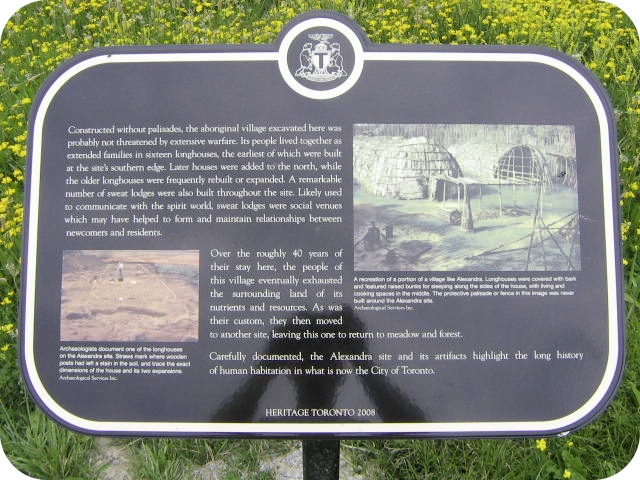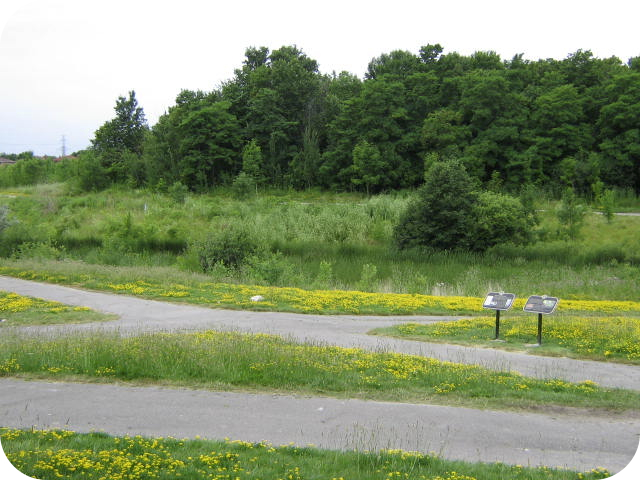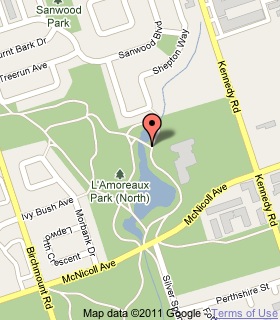Discover Toronto's history as told through its plaques
2004 - Now in our 15th Year - 2019
To see what's new on this site, you can visit the Home Page
Looking at this page on a smartphone?
For best viewing, hold your phone in Landscape mode (Horizontal)
The Alexandra Site

Photos by Alan L Brown - Posted July, 2009


In L'Amoreaux Park, on the north side of McNicoll Avenue between Birchmount and Kennedy Roads, can be found this set of two 2008 Heritage Toronto plaques which tell us what is was like here about 600 years ago. Here's what they say:
Coordinates: 43.812944 -79.306462 |
 |
About 600 years ago, this was the site of a vibrant village of 800 to 1000 people, ancestors of the Huron-Wendat nation. Though their name for this place is lost, their village was discovered under a farmer's field and named the Alexandra site in 2001. In a lengthy excavation, archaeologists revealed evidence of longhouses, sweat lodges, and garbage pits. Nearly 20,000 artifacts were documented and collected from the site before it was developed as a residential subdivision. No human burials were found.
Among this site's artifacts were beads made of sea shells from the eastern seaboard - proof that the people here were linked to extensive trading networks. This was also an agricultural community surrounded by cultivated fields of corns, beans, squash, sunflower, and tobacco. Remains of deer, lake trout and wild berries, among other animals and wild plants, indicate that hunting, fishing and gathering also supported the community. The village's location on a small ridge above a waterway (now the altered Highland Creek) provided it with fish and fresh water.
Constructed without palisades, the aboriginal village excavated here was probably not threatened by extensive warfare. Its people lived together as extended families in sixteen longhouses, the earliest of which were built at the site's southern edge. Later houses were added to the north, while the older longhouses were frequently rebuilt throughout the site. Likely used to communicate with the spirit world, sweat lodges were social venues which may have helped to form and maintain relationships between newcomers and residents.
Over the roughly 40 years of their stay here, the people of this village eventually exhausted the surrounding land of its nutrients and resources. As was their custom, they then moved to another site, leaving this one to return to meadow and forest.
Carefully documented, the Alexandra site and its artifacts highlight the long history of human habitation in what is now the City of Toronto.
Related webpages
Alexandra site
Huron-Wendat nation
longhouses
sweat lodges
Highland Creek
palisades
Related Toronto plaques
Indian Village Site
The Jackes Site
Parsons Site
Withrow Archaeological Site
Related Ontario plaques
Crawford Lake Indian Village Site
Cummins Site
The Lawson Site
The Nodwell Indian Village Site
Roebuck Indian Village Site
Upper Gap Archaeological Site
More
First Nations
Here are the visitors' comments for this page.
(none yet)
Here's where you can send me a comment for this page.
Note: Your email address will be posted at the end of your comment so others can respond to you unless you request otherwise.
Note: Comments are moderated. Yours will appear on this page within 24 hours (usually much sooner).
Note: As soon as I have posted your comment, a reply to your email will be sent informing you.
To send me your comment, click [email protected].
Thanks
Webmaster
Note: If you wish to send me a personal email, click here.